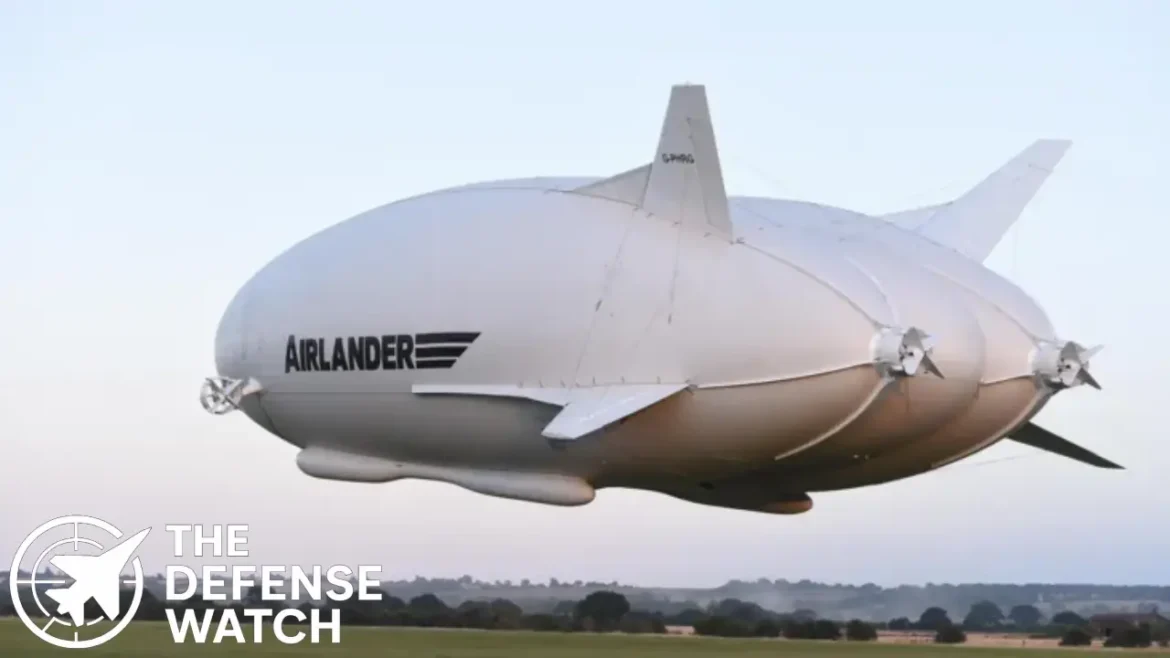British aerospace firm Hybrid Air Vehicles (HAV) has announced its first military reservations for the Airlander 10, a hybrid aircraft combining the capabilities of an airship and a fixed-wing plane. The Bedford-based company confirmed that an “innovative defense contractor” has reserved three Airlander 10s for military customization — a major milestone as the platform moves closer to production.
While initially designed for civil certification, HAV emphasized that Airlander’s modular design and multi-role adaptability make it ideal for military use, especially in Intelligence, Surveillance, and Reconnaissance (ISR) missions.
“This is an exciting moment for us,” said George Land, Executive Director of Sales at HAV. “We’re pleased to be working with an undisclosed customer to provide three aircraft for further customization. Airlander’s versatility, high payload, and endurance offer clear advantages for modern defense needs.”
A New Kind of Military Platform
The Airlander 10 represents a new category of aircraft — part airship, part airplane — designed for long-endurance missions with low operational costs. It uses four combustion engines for lift and maneuvering, and can remain airborne for up to five days without refueling. Its three-tonne payload capacity allows it to carry high-performance radar systems, communications arrays, or even small drones.
Key Military Capabilities:
- Persistent ISR: Capable of carrying advanced radar and sensor suites for extended surveillance operations.
- Drone Operations: Can deploy, recover, and manage unmanned systems in the air.
- Multi-Terrain Operations: Operates from any flat surface, including water, without the need for runways.
- Logistics Support: Can transport personnel and equipment to remote or austere environments.
- Anti-Submarine Warfare Support: Provides long-duration monitoring for maritime patrol operations.
HAV said Airlander 10’s endurance and cost efficiency make it a unique solution for modern hybrid warfare, where persistent surveillance and flexible logistics are increasingly critical.
Manufacturing and Expansion Plans
Construction of HAV’s new production facility in Doncaster, England, began in December 2024. The site is expected to begin assembly and flight testing by 2026, with full-scale production following soon after. The Airlander 10 is projected to measure around 320 feet (98 meters) in length, making it the world’s longest aircraft.
The company’s civilian ventures are also growing. Spanish operator Air Nostrum Group, which previously reserved 10 Airlanders for regional passenger service, has doubled its order to 20 units for delivery by 2027. The expansion signals growing confidence in Airlander’s commercial and defense viability.
Strategic Significance for Military Operations
The growing military interest in hybrid aircraft aligns with broader trends in defense modernization. Traditional ISR and logistics aircraft — such as the P-8 Poseidon or C-130 Hercules — are effective but costly to operate and limited in endurance.
By contrast, the Airlander 10 offers a longer on-station time and lower operational footprint. Its ability to loiter for days over conflict zones or maritime areas could make it an affordable alternative for persistent surveillance and battlefield awareness.
For U.S. and NATO militaries, platforms like Airlander could supplement or even partially replace satellite-based ISR assets for certain missions, especially in contested environments where low-altitude persistence is key. Its minimal ground infrastructure requirements also make it ideal for forward-deployed or expeditionary operations.
Analysis: The Return of the Airship in Modern Warfare
The military’s renewed interest in lighter-than-air technology signals a shift toward endurance-based intelligence platforms. While airships were largely phased out after World War II, advances in composite materials, propulsion, and autonomous control systems are driving a resurgence.
In the U.S., similar efforts — such as Lockheed Martin’s LMH-1 hybrid airship and DARPA’s Project ISIS — have explored the potential of persistent aerial platforms for communications and surveillance. The Airlander 10 could serve as a European counterpart, potentially collaborating with allied defense programs focused on low-cost, high-endurance assets.
Moreover, Airlander’s low carbon footprint compared to traditional aircraft supports growing military goals for sustainable aviation technologies, particularly within NATO and European defense frameworks.
Conclusion: A New Frontier for Military Aviation
With its first military reservations confirmed, Hybrid Air Vehicles is positioning the Airlander 10 as a game-changing platform in the evolving landscape of aerial defense and surveillance. The aircraft’s endurance, versatility, and low operational costs offer defense organizations a new tool to adapt to emerging global threats — from maritime security to border monitoring and disaster response.
As HAV prepares for production in 2026, industry analysts expect further military orders to follow — potentially from U.S. allies seeking persistent, cost-effective ISR capabilities.
If successful, the Airlander 10 could mark the return of the airship — not as a relic of the past, but as a critical asset in the future of modern warfare.


1 comment
[…] EDGE and Anduril have formed a joint venture, dubbed the EDGE-Anduril Production Alliance, to develop and manufacture the Omen autonomous air vehicle. […]